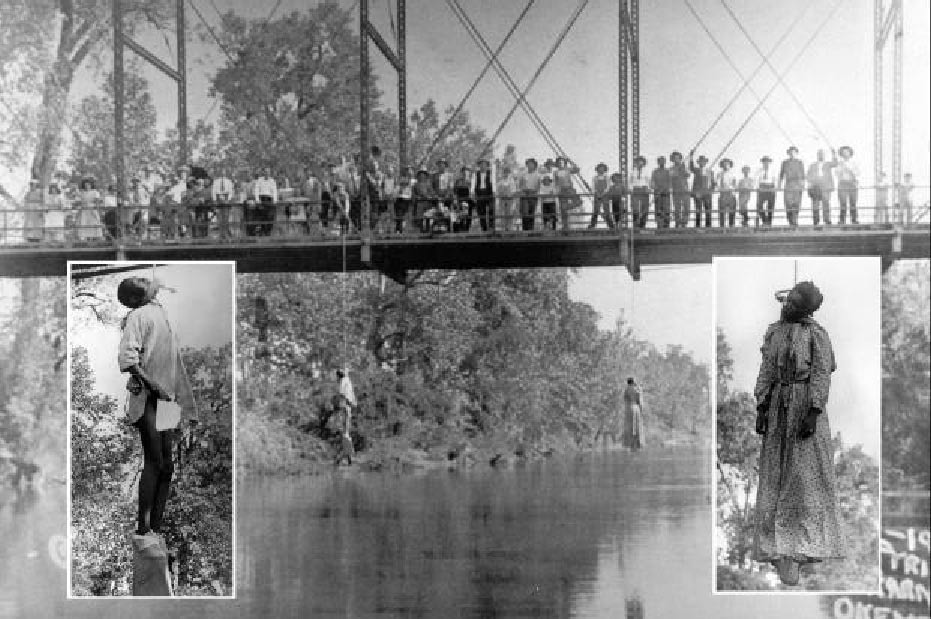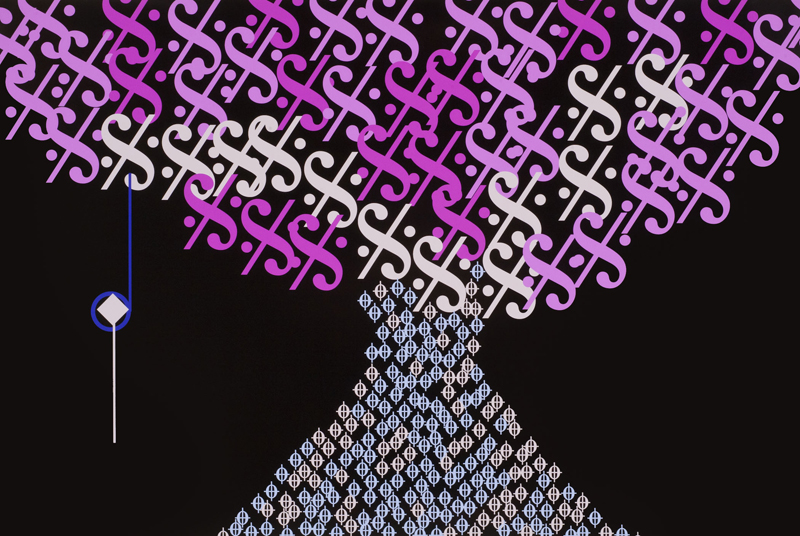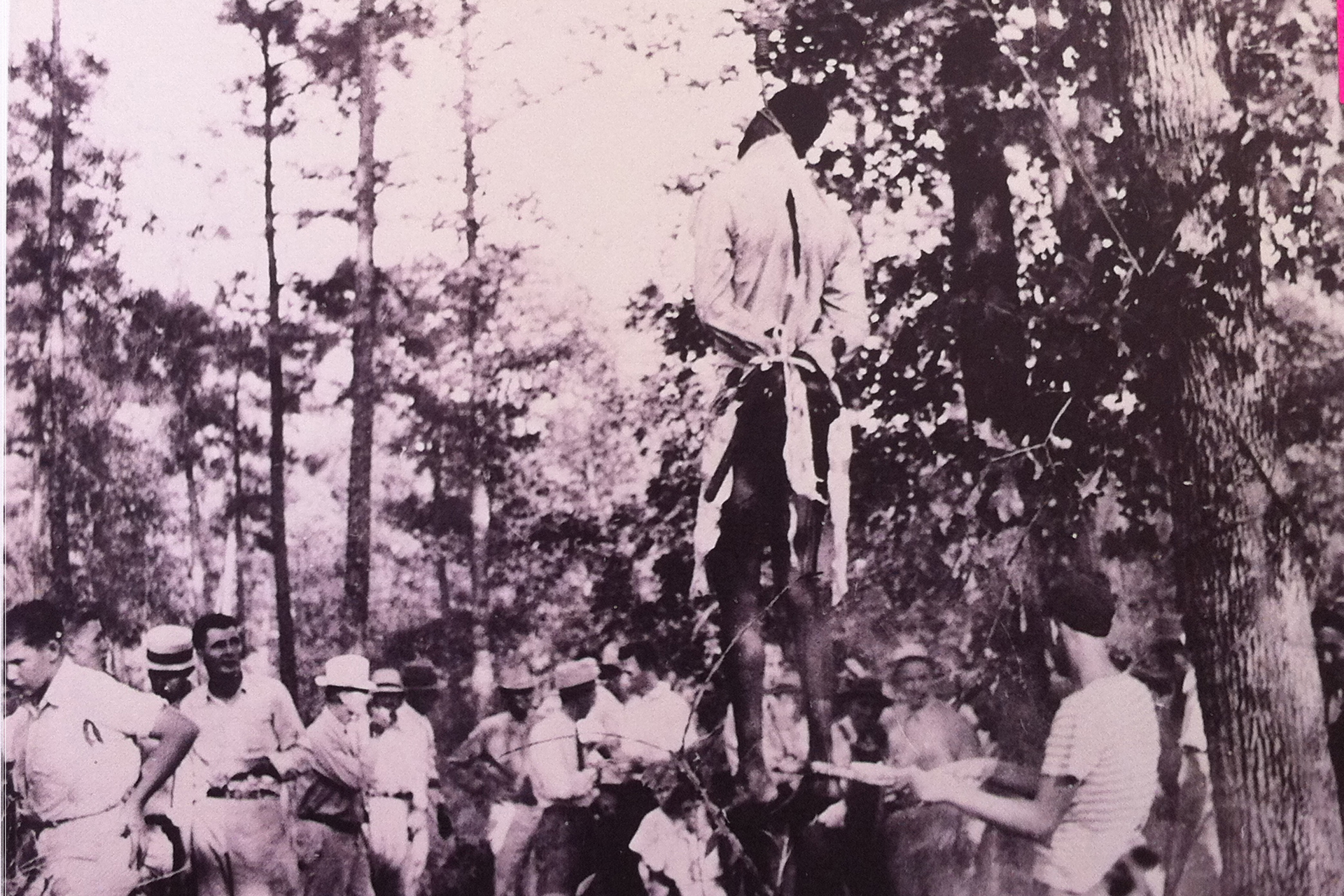Stories from the Trees reimagines vintage postcards of lynchings with animation, live restaging of attendants, new composition, and live performance. Based on one survey, 4,742 African Americans were murdered by lynching between 1882 and 1968. Others were lynched as well, but not nearly in the same numbers- including people of Caucasian, Chinese, Latino, and Jewish descent. This project brings to life the different scenarios of lynchings, events where communities gathered with women and children proudly watching these atrocities. The images draw from postcards that were made from photographs of lynchings as common practice.
Funded by 2014 MAP Fund Grant
The history of lynching in America is a chapter in our history that seldom gets addressed. There are similarities between death by lynching and the flood of shootings and killing by other methods in present day America. In sync with the extrajudicial quality of lynching, today’s murders often go unprosecuted, or, if they go to trial, often end in acquittal of the accused. The psychological impact of lynching remains with us today. People of color fear vigilante justice. These crimes frequently go unpunished, whether committed by citizens or by the police. This inequity is a legitimate concern.
My desire to create Stories from the Trees comes from the need for more people to hear the stories about what happened in a not so distant and shadowy past.
Funded by 2014 MAP Fund Grant
The history of lynching in America is a chapter in our history that seldom gets addressed. There are similarities between death by lynching and the flood of shootings and killing by other methods in present day America. In sync with the extrajudicial quality of lynching, today’s murders often go unprosecuted, or, if they go to trial, often end in acquittal of the accused. The psychological impact of lynching remains with us today. People of color fear vigilante justice. These crimes frequently go unpunished, whether committed by citizens or by the police. This inequity is a legitimate concern.
My desire to create Stories from the Trees comes from the need for more people to hear the stories about what happened in a not so distant and shadowy past.
-
 Strange Fruit from Four Score InstallationThis score is a graphic musical depiction that calls to mind the trees in the Southern part of the U.S. that were once used in lynchings. I grew up in South Carolina, where many of these trees still stand. A play on Abraham Lincoln’s Gettysburg address, and four graphic musical scores. The viewer is given an MP3 player and listens to corresponding compositions and arrangements. Each score measure 42 inches x 60 inches. A video of the full work is located here: https://www.youtube.com/watch?v=9hLG0xrhSoc Digital Still
Strange Fruit from Four Score InstallationThis score is a graphic musical depiction that calls to mind the trees in the Southern part of the U.S. that were once used in lynchings. I grew up in South Carolina, where many of these trees still stand. A play on Abraham Lincoln’s Gettysburg address, and four graphic musical scores. The viewer is given an MP3 player and listens to corresponding compositions and arrangements. Each score measure 42 inches x 60 inches. A video of the full work is located here: https://www.youtube.com/watch?v=9hLG0xrhSoc Digital Still -
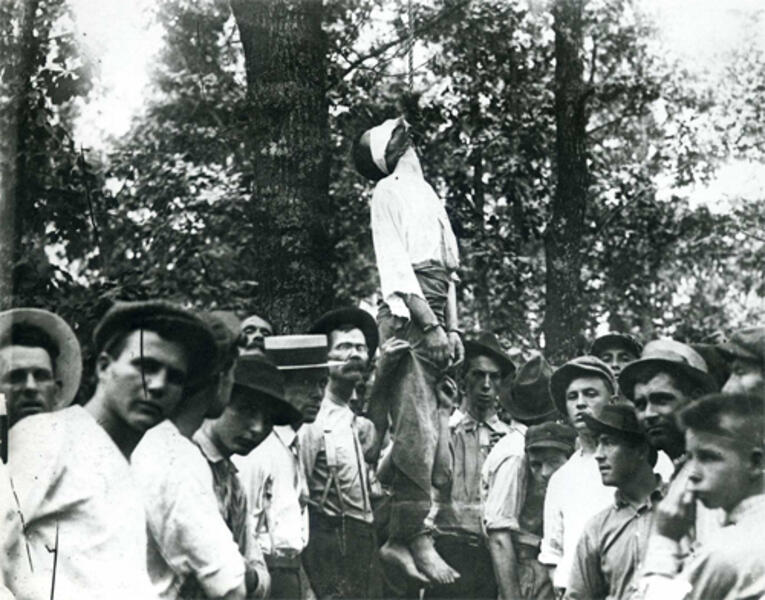 Leo Frank Lynching - 1915- Work in ProgressLynching of Leo Frank Currently working on installation about the Georgia lynching of Jewish factory manager Leo Frank in 1915 who was accused of rape and murder. Leo Max Frank (April 17, 1884 – August 17, 1915) was a Jewish-American factory superintendent whose murder conviction and extrajudicial hanging in 1915 by a lynch mob planned and led by prominent citizens in Marietta, Georgia, drew attention to questions of antisemitism in the United States. Frank was posthumously pardoned in 1986 which the Georgia State Board of Pardons and Paroles stated was "in an effort to heal old wounds," without officially absolving him of the crime. An engineer and superintendent of the National Pencil Company in Atlanta, Frank was convicted on August 25, 1913, of the murder of one of his factory workers, 13-year-old Mary Phagan. She had been strangled on April 26 and was found dead in the factory cellar the next morning. Frank was the last person known to have seen her alive, and there were allegations that he had flirted with her before. His trial became the focus of powerful class, regional, and political interests. Raised in New York, he was cast as a representative of Yankee capitalism, a rich northern Jew in contrast to the poverty experienced by Phagan and many Southerners of the time. One year after the trial, former U.S. Representative Thomas E. Watson used sensational coverage of the appeal process in his own publications, calling Frank a member of the Jewish aristocracy who had pursued "Our Little Girl" to a hideous death. During the trial, Frank and his lawyers resorted to stereotypes, accusing another suspect — Jim Conley, a black factory worker who testified against Frank — of being especially disposed to lying and murdering because of his race. There was jubilation in the streets when Frank was convicted and sentenced to death. By April 1915, his appeals had failed. Governor John M. Slaton, stating that guilt had not been proven with absolute certainty, commuted the sentence to life imprisonment, to great local outrage. A crowd of 1,200 marched on Slaton's home in protest. Two months later, Frank was kidnapped from prison by a group of 25 armed men who called themselves "Knights of Mary Phagan". Frank was driven 170 miles to Frey's Gin, near Phagan's home in Marietta, and lynched. A crowd gathered after the hanging; one man repeatedly stomped on Frank's face, while others took photographs, pieces of his nightshirt, and bits of the rope to sell as souvenirs.
Leo Frank Lynching - 1915- Work in ProgressLynching of Leo Frank Currently working on installation about the Georgia lynching of Jewish factory manager Leo Frank in 1915 who was accused of rape and murder. Leo Max Frank (April 17, 1884 – August 17, 1915) was a Jewish-American factory superintendent whose murder conviction and extrajudicial hanging in 1915 by a lynch mob planned and led by prominent citizens in Marietta, Georgia, drew attention to questions of antisemitism in the United States. Frank was posthumously pardoned in 1986 which the Georgia State Board of Pardons and Paroles stated was "in an effort to heal old wounds," without officially absolving him of the crime. An engineer and superintendent of the National Pencil Company in Atlanta, Frank was convicted on August 25, 1913, of the murder of one of his factory workers, 13-year-old Mary Phagan. She had been strangled on April 26 and was found dead in the factory cellar the next morning. Frank was the last person known to have seen her alive, and there were allegations that he had flirted with her before. His trial became the focus of powerful class, regional, and political interests. Raised in New York, he was cast as a representative of Yankee capitalism, a rich northern Jew in contrast to the poverty experienced by Phagan and many Southerners of the time. One year after the trial, former U.S. Representative Thomas E. Watson used sensational coverage of the appeal process in his own publications, calling Frank a member of the Jewish aristocracy who had pursued "Our Little Girl" to a hideous death. During the trial, Frank and his lawyers resorted to stereotypes, accusing another suspect — Jim Conley, a black factory worker who testified against Frank — of being especially disposed to lying and murdering because of his race. There was jubilation in the streets when Frank was convicted and sentenced to death. By April 1915, his appeals had failed. Governor John M. Slaton, stating that guilt had not been proven with absolute certainty, commuted the sentence to life imprisonment, to great local outrage. A crowd of 1,200 marched on Slaton's home in protest. Two months later, Frank was kidnapped from prison by a group of 25 armed men who called themselves "Knights of Mary Phagan". Frank was driven 170 miles to Frey's Gin, near Phagan's home in Marietta, and lynched. A crowd gathered after the hanging; one man repeatedly stomped on Frank's face, while others took photographs, pieces of his nightshirt, and bits of the rope to sell as souvenirs. -
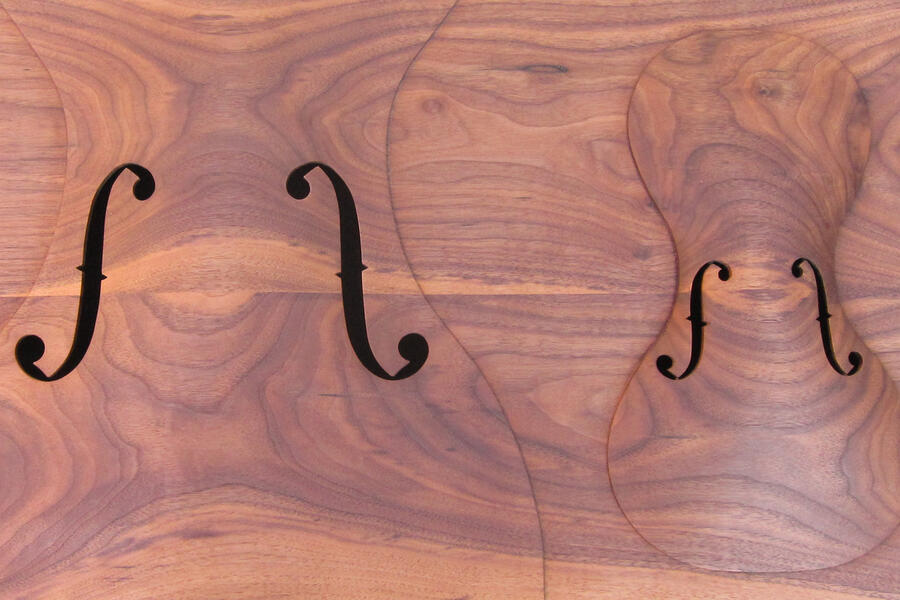 May 25, 1911Lynching of Laura and L.D. Nelson Laura and L.D. Nelson (born 1878 and 1897) were an African-American mother and son who were lynched on May 25, 1911, near Okemah, the county seat of Okfuskee County, Oklahoma. Laura, her husband Austin, their teenage son L.D., and possibly their child had been taken into custody after George Loney, Okemah's deputy sheriff, and three others arrived at the Nelsons' home on May 2, 1911, to investigate the theft of a cow. The son shot Loney, who was hit in the leg and bled to death; Laura was reportedly the first to grab the gun and was charged with murder, along with her son. Her husband pleaded guilty to larceny, and was sent to the relative safety of the state prison in McAlester. The son L.D. Nelson was held in the county jail in Okemah and the mother Laura in a cell in the nearby courthouse to await trial. At around midnight on May 24, Laura and L.D. Nelson were both kidnapped from their cells by a group of between a dozen and 40 men; the group included Charley Guthrie (1879–1956), the father of folk singer Woody Guthrie (1912–1967), according to a statement given in 1977 by the former's brother. The Crisis, the magazine of the National Association for the Advancement of Colored People, said in July 1911 that Laura was raped, then she and L.D. were hanged from a bridge over the North Canadian River. According to some sources, Laura had a baby with her at the time, who one witness said survived the attack. Sightseers gathered on the bridge the following morning and photographs of the hanging bodies were sold as postcards; the one of Laura is the only known surviving photograph of a female lynching victim. No one was ever charged with the murders; the district judge convened a grand jury, but the killers were never identified. Although Woody Guthrie was not born until 14 months after the lynching, the photographs and his father's reported involvement had a lasting effect on him, and he wrote several songs about the killings. The Nelsons were among at least 4,743 people lynched in the United States between 1888 and 1968, 3,446 (72.7 percent) of them black, 73 percent of them in the South, around 150 of them women. Walnut and purfling Dimensions: 16x22
May 25, 1911Lynching of Laura and L.D. Nelson Laura and L.D. Nelson (born 1878 and 1897) were an African-American mother and son who were lynched on May 25, 1911, near Okemah, the county seat of Okfuskee County, Oklahoma. Laura, her husband Austin, their teenage son L.D., and possibly their child had been taken into custody after George Loney, Okemah's deputy sheriff, and three others arrived at the Nelsons' home on May 2, 1911, to investigate the theft of a cow. The son shot Loney, who was hit in the leg and bled to death; Laura was reportedly the first to grab the gun and was charged with murder, along with her son. Her husband pleaded guilty to larceny, and was sent to the relative safety of the state prison in McAlester. The son L.D. Nelson was held in the county jail in Okemah and the mother Laura in a cell in the nearby courthouse to await trial. At around midnight on May 24, Laura and L.D. Nelson were both kidnapped from their cells by a group of between a dozen and 40 men; the group included Charley Guthrie (1879–1956), the father of folk singer Woody Guthrie (1912–1967), according to a statement given in 1977 by the former's brother. The Crisis, the magazine of the National Association for the Advancement of Colored People, said in July 1911 that Laura was raped, then she and L.D. were hanged from a bridge over the North Canadian River. According to some sources, Laura had a baby with her at the time, who one witness said survived the attack. Sightseers gathered on the bridge the following morning and photographs of the hanging bodies were sold as postcards; the one of Laura is the only known surviving photograph of a female lynching victim. No one was ever charged with the murders; the district judge convened a grand jury, but the killers were never identified. Although Woody Guthrie was not born until 14 months after the lynching, the photographs and his father's reported involvement had a lasting effect on him, and he wrote several songs about the killings. The Nelsons were among at least 4,743 people lynched in the United States between 1888 and 1968, 3,446 (72.7 percent) of them black, 73 percent of them in the South, around 150 of them women. Walnut and purfling Dimensions: 16x22 -
 Lynching of Laura and L.D. Nelson - Original Lynching PostcardLynching of Laura and L.D. Nelson Laura and L.D. Nelson (born 1878 and 1897) were an African-American mother and son who were lynched on May 25, 1911, near Okemah, the county seat of Okfuskee County, Oklahoma. Laura, her husband Austin, their teenage son L.D., and possibly their child had been taken into custody after George Loney, Okemah's deputy sheriff, and three others arrived at the Nelsons' home on May 2, 1911, to investigate the theft of a cow. The son shot Loney, who was hit in the leg and bled to death; Laura was reportedly the first to grab the gun and was charged with murder, along with her son. Her husband pleaded guilty to larceny, and was sent to the relative safety of the state prison in McAlester. The son L.D. Nelson was held in the county jail in Okemah and the mother Laura in a cell in the nearby courthouse to await trial. At around midnight on May 24, Laura and L.D. Nelson were both kidnapped from their cells by a group of between a dozen and 40 men; the group included Charley Guthrie (1879–1956), the father of folk singer Woody Guthrie (1912–1967), according to a statement given in 1977 by the former's brother. The Crisis, the magazine of the National Association for the Advancement of Colored People, said in July 1911 that Laura was raped, then she and L.D. were hanged from a bridge over the North Canadian River. According to some sources, Laura had a baby with her at the time, who one witness said survived the attack. Sightseers gathered on the bridge the following morning and photographs of the hanging bodies were sold as postcards; the one of Laura is the only known surviving photograph of a female lynching victim. No one was ever charged with the murders; the district judge convened a grand jury, but the killers were never identified. Although Woody Guthrie was not born until 14 months after the lynching, the photographs and his father's reported involvement had a lasting effect on him, and he wrote several songs about the killings. The Nelsons were among at least 4,743 people lynched in the United States between 1888 and 1968, 3,446 (72.7 percent) of them black, 73 percent of them in the South, around 150 of them women.
Lynching of Laura and L.D. Nelson - Original Lynching PostcardLynching of Laura and L.D. Nelson Laura and L.D. Nelson (born 1878 and 1897) were an African-American mother and son who were lynched on May 25, 1911, near Okemah, the county seat of Okfuskee County, Oklahoma. Laura, her husband Austin, their teenage son L.D., and possibly their child had been taken into custody after George Loney, Okemah's deputy sheriff, and three others arrived at the Nelsons' home on May 2, 1911, to investigate the theft of a cow. The son shot Loney, who was hit in the leg and bled to death; Laura was reportedly the first to grab the gun and was charged with murder, along with her son. Her husband pleaded guilty to larceny, and was sent to the relative safety of the state prison in McAlester. The son L.D. Nelson was held in the county jail in Okemah and the mother Laura in a cell in the nearby courthouse to await trial. At around midnight on May 24, Laura and L.D. Nelson were both kidnapped from their cells by a group of between a dozen and 40 men; the group included Charley Guthrie (1879–1956), the father of folk singer Woody Guthrie (1912–1967), according to a statement given in 1977 by the former's brother. The Crisis, the magazine of the National Association for the Advancement of Colored People, said in July 1911 that Laura was raped, then she and L.D. were hanged from a bridge over the North Canadian River. According to some sources, Laura had a baby with her at the time, who one witness said survived the attack. Sightseers gathered on the bridge the following morning and photographs of the hanging bodies were sold as postcards; the one of Laura is the only known surviving photograph of a female lynching victim. No one was ever charged with the murders; the district judge convened a grand jury, but the killers were never identified. Although Woody Guthrie was not born until 14 months after the lynching, the photographs and his father's reported involvement had a lasting effect on him, and he wrote several songs about the killings. The Nelsons were among at least 4,743 people lynched in the United States between 1888 and 1968, 3,446 (72.7 percent) of them black, 73 percent of them in the South, around 150 of them women. -
 WIND - from Sounds Like....WIND from the installation Sounds Like..., I use music notation to represent a lynching. Early on I thought the actual images of lynchings would be too horrific to use in my art, so I opted for a more subtle approach. Two years later I started working with actual lynching postcards. Sounds Like… is a sound installation without sound. The four pairings of large images and video are based on the classic elements: Earth, Air, Fire, and Water. Each pairing also represents a significant event in US history relating to Americans of African descent, and their experiences. From broken promises associated with 40 acres and a mule, to the horrors of lynching, and the murder of Emmett Till, as well as honoring the spirit of those who fought for their rights. Video: https://www.youtube.com/watch?v=g9LtOC0lFZw Digital still
WIND - from Sounds Like....WIND from the installation Sounds Like..., I use music notation to represent a lynching. Early on I thought the actual images of lynchings would be too horrific to use in my art, so I opted for a more subtle approach. Two years later I started working with actual lynching postcards. Sounds Like… is a sound installation without sound. The four pairings of large images and video are based on the classic elements: Earth, Air, Fire, and Water. Each pairing also represents a significant event in US history relating to Americans of African descent, and their experiences. From broken promises associated with 40 acres and a mule, to the horrors of lynching, and the murder of Emmett Till, as well as honoring the spirit of those who fought for their rights. Video: https://www.youtube.com/watch?v=g9LtOC0lFZw Digital still -
Lynching Postcard - Work in ProgressThis video shows the separation of layers. I'm currently animating this video to be part of a performance piece funded by MAP Fund. I'm animating 10-15 postcards and will perform new original composition in a staged production entitled Stories from the Trees.
-
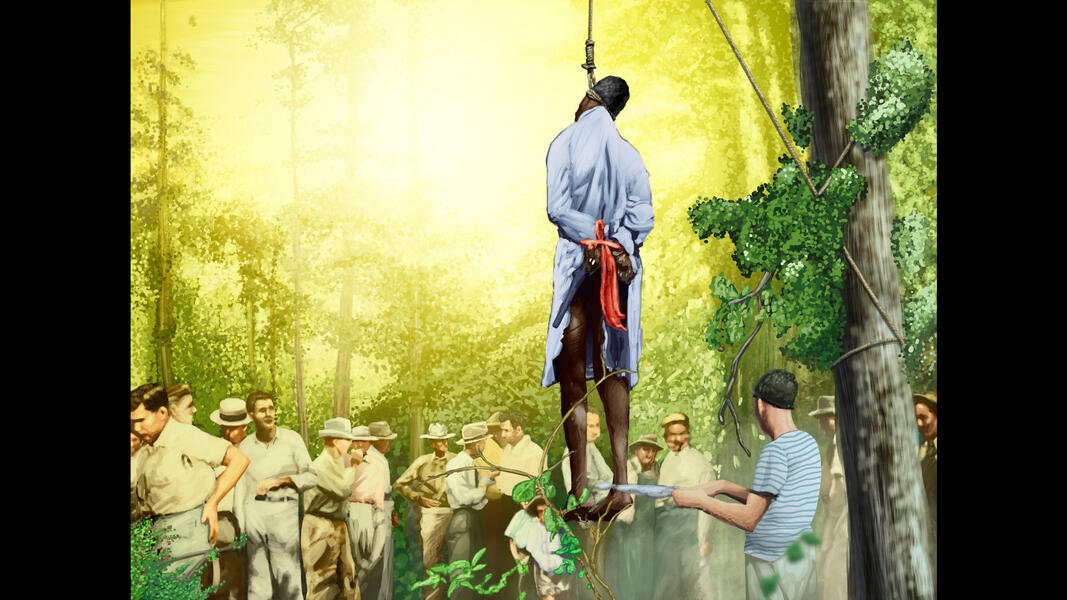 October 15, 1938 - Work in ProgressLynching in Louisiana colorized The lynching of W. C. or R. C. Williams, his body hanging from an oak tree, lower body covered with kitchen apron, blood streaming down legs suggests castration, onlookers include white men and young children. ________ News Report: Lynch Law - Ruston, LA The shot riddled body of negro W. C. Williams hangs from the towering oak tree less than 150 yards from where the murder and assault for which he was killed were committed. A mob of 300 persons administered lynch law after Williams admitted that he had clubbed mill worker Robert N. Blair to death and criminally assaulted his girl companion. The mob took Williams from the posse which had captured him after a three day hunt, strung him up to the tree, then riddled his body with bullets.
October 15, 1938 - Work in ProgressLynching in Louisiana colorized The lynching of W. C. or R. C. Williams, his body hanging from an oak tree, lower body covered with kitchen apron, blood streaming down legs suggests castration, onlookers include white men and young children. ________ News Report: Lynch Law - Ruston, LA The shot riddled body of negro W. C. Williams hangs from the towering oak tree less than 150 yards from where the murder and assault for which he was killed were committed. A mob of 300 persons administered lynch law after Williams admitted that he had clubbed mill worker Robert N. Blair to death and criminally assaulted his girl companion. The mob took Williams from the posse which had captured him after a three day hunt, strung him up to the tree, then riddled his body with bullets. -
 October 15, 1938 - Work in ProgressLynching in Louisiana pre-colorized, Work in Progress The lynching of W. C. or R. C. Williams, his body hanging from an oak tree, lower body covered with kitchen apron, blood streaming down legs suggests castration, onlookers include white men and young children. ______ News Report: Lynch Law - Ruston, LA The shot riddled body of negro W. C. Williams hangs from the towering oak tree less than 150 yards from where the murder and assault for which he was killed were committed. A mob of 300 persons administered lynch law after Williams admitted that he had clubbed mill worker Robert N. Blair to death and criminally assaulted his girl companion. The mob took Williams from the posse which had captured him after a three day hunt, strung him up to the tree, then riddled his body with bullets.
October 15, 1938 - Work in ProgressLynching in Louisiana pre-colorized, Work in Progress The lynching of W. C. or R. C. Williams, his body hanging from an oak tree, lower body covered with kitchen apron, blood streaming down legs suggests castration, onlookers include white men and young children. ______ News Report: Lynch Law - Ruston, LA The shot riddled body of negro W. C. Williams hangs from the towering oak tree less than 150 yards from where the murder and assault for which he was killed were committed. A mob of 300 persons administered lynch law after Williams admitted that he had clubbed mill worker Robert N. Blair to death and criminally assaulted his girl companion. The mob took Williams from the posse which had captured him after a three day hunt, strung him up to the tree, then riddled his body with bullets. -
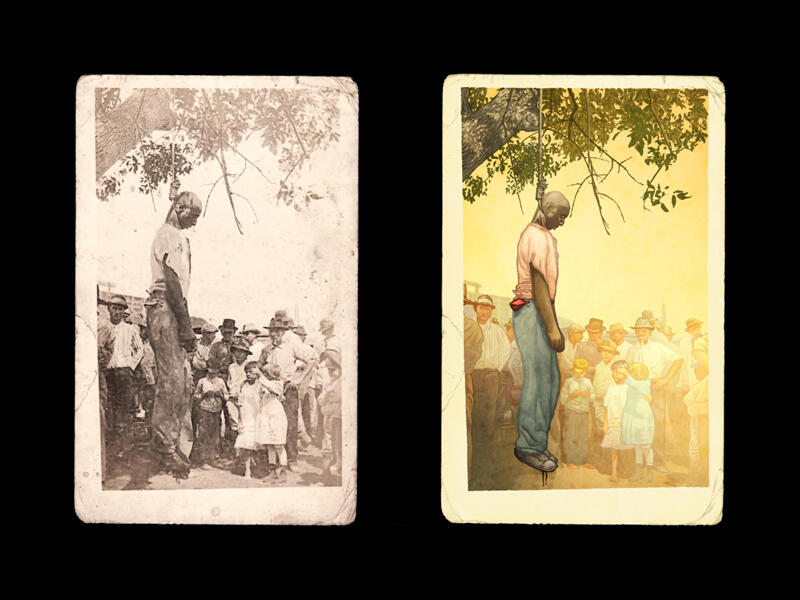 Stories from the Trees - Stills from submitted videoLynching postcard circa 1915. Pre-animation and still from animation.
Stories from the Trees - Stills from submitted videoLynching postcard circa 1915. Pre-animation and still from animation. -
Stories from the Trees - Animated Lynching PostcardStories from the Trees reimagines vintage lynching postcards with animation, live restaging of attendants, new composition, and live performance. Based on one survey, 4,742 African Americans were murdered by lynching between 1882 and 1968. Others were lynched as well, but not nearly in the same numbers- including people of Caucasian, Chinese, Latino, and Jewish descent. This project brings to life the different scenarios of lynchings, places where communities gathered with women and children proudly watching these atrocities. The images draw from postcards that were made from photographs of lynchings as common practice. Funded by 2014 MAP Fund



